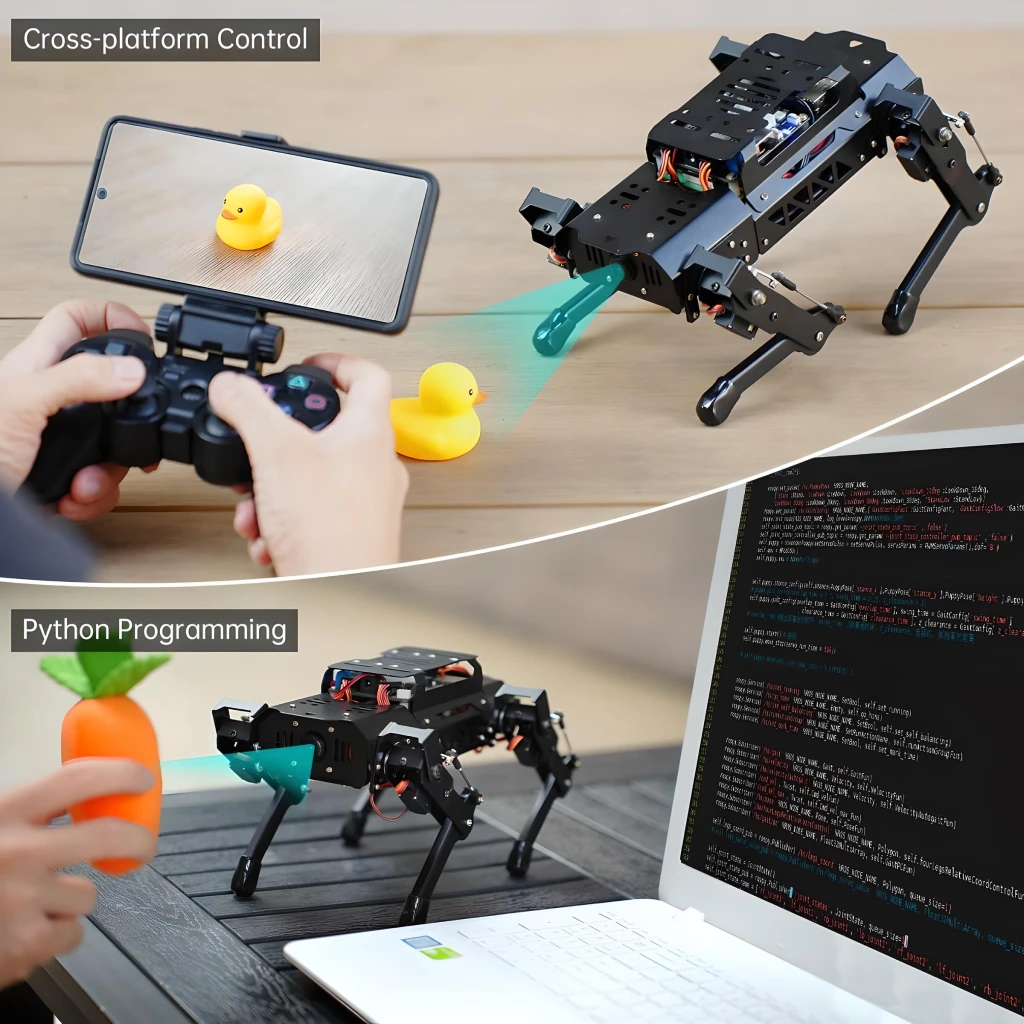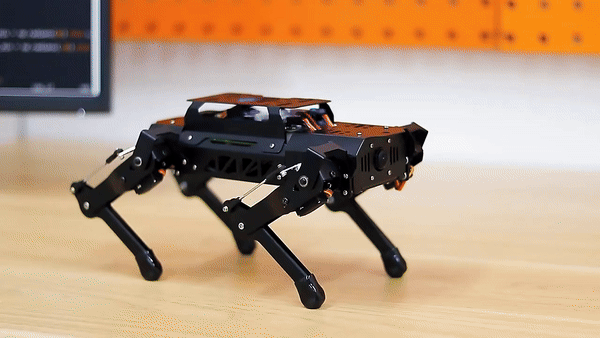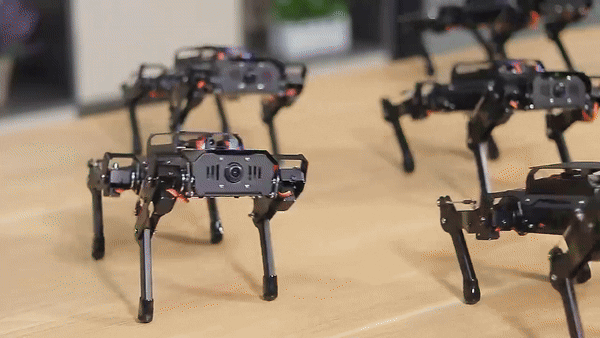Discovering My Passion for Robotics Through the AI Vision Quadruped Robot

By Alex Carter, Robotics Enthusiast
As a robotics hobbyist and someone who works in tech education, I’ve had the privilege of using many gadgets and tools over the years. However, few products have managed to captivate me as much as the AI Vision Quadruped Robot. This robot isn’t just another fancy gadget to collect dust on a shelf—it’s a remarkable tool for learning, experimenting, and even teaching others about the wonders of robotics and artificial intelligence.
When I first came across the Quadruped Robot, I was searching for something interactive that could help me dive deeper into AI programming and kinematics. My initial thought was that this would be a cool toy to tinker with over the weekends, but I soon realized it was so much more than that. Here’s my journey with this incredible piece of technology and why I believe it’s worth every penny for anyone passionate about robotics or even just curious about the future of technology.
First Impressions: The Build and Unboxing Experience
When the Quadruped Robot arrived, I was immediately struck by how premium everything felt. The packaging was sleek and organized, which is always a good sign. Inside, I found the robot neatly assembled (I chose the Standard Kit), a Raspberry Pi 4B 4GB, a user manual, and access to a range of tutorials and codes.
The body of the robot is made of sturdy aluminum alloy, giving it a professional, durable feel. The attention to detail in the build quality was impressive—the joints and servos moved smoothly, and the overall design felt polished. Even before powering it on, I could tell this wasn’t a flimsy toy but a serious piece of tech.
The manual and resources provided were clear and easy to follow, which is a big deal for anyone starting out with robotics. I appreciated that the company didn’t just ship a product—they provided all the tools and instructions I needed to get started right away.

Setting It Up: A Smooth Start
As someone who has struggled with poorly designed software interfaces in the past, I was relieved at how intuitive the setup process was. The Quadruped Robot is based on ROS (Robot Operating System), which is an industry-standard platform for robot programming. While I had some experience with ROS before, I could see how even a beginner could grasp the basics thanks to the tutorials provided.
The Raspberry Pi 4B was preloaded with everything I needed, so getting the robot up and running took less than 30 minutes. I installed the companion app on my laptop, connected the robot to Wi-Fi, and was ready to dive in.
What stood out to me during setup was how much this robot is designed to accommodate users at all skill levels. Whether you’re a child exploring robotics for the first time or an advanced user looking to push the limits of AI programming, this product meets you where you are.
First Run: Watching It Come to Life
The first time I powered on the Quadruped Robot and saw it move, I couldn’t help but grin. The 8 high-precision coreless servos allow it to walk, trot, and even climb stairs with fluid, lifelike motion. Watching it navigate my living room felt surreal—I was essentially controlling a mini robot dog that moved with surprising agility.
The AI vision system was another jaw-dropping feature. I programmed the robot to track a target, and it locked onto the object with incredible precision. I also experimented with its face detection feature, and it recognized my face instantly, following me as I moved around the room. The responsiveness was impressive, and it made me feel like I was interacting with a living, intelligent machine.
Another feature I tested early on was the robot’s ability to follow lines. I set up a simple course on the floor using black tape, and the robot followed it perfectly, adjusting its movements in real time. These capabilities not only showcased the advanced AI but also opened up endless possibilities for future experiments.

Diving Deeper: Experimenting with Open-Source Programming
What sets the AI Vision Quadruped Robot apart from other robotics products I’ve tried is its open-source programming capabilities. For someone like me, who enjoys writing and customizing code, this was a dream come true.
The robot comes with a library of open-source codes and examples to help you start experimenting right away. I began with some basic modifications, like altering the robot’s walking speed and gait patterns. The tutorials provided clear explanations of how the code worked, making it easy to tweak things and see the results immediately.
Once I got the hang of it, I moved on to more advanced projects. Using Python, I programmed the robot to recognize specific hand gestures and respond accordingly. For example, I could wave my hand in front of the camera to make the robot sit, or point in a direction to make it walk that way.
I also integrated an external microphone to give the robot voice commands. With a bit of coding, I was able to tell the robot to “go forward,” “turn left,” or “stop,” and it would respond accurately. This project taught me a lot about machine vision, natural language processing, and the power of AI in robotics.
Using It as a Teaching Tool
One of the most rewarding aspects of owning the Quadruped Robot has been using it as a teaching tool. I run a small coding club for middle school students, and the robot quickly became the highlight of our sessions.
The kids were fascinated by its lifelike movements and AI capabilities. I introduced them to the basics of robotics by showing them how to control the robot’s movements and program simple tasks. With the provided tutorials, even the younger students were able to write their first lines of code and see their work come to life.
The robot’s visual AI features, like face detection and target tracking, were especially popular. The students loved seeing the robot recognize their faces or follow objects they held up. These interactive features made learning fun and kept everyone engaged.
What I appreciated most was how the Quadruped Robot served as a bridge between theory and practice. Concepts like kinematics and computer vision can be intimidating in a classroom setting, but this robot made them tangible and approachable.

Everyday Use: Fun and Functional
Beyond its educational value, the AI Vision Quadruped Robot has been a source of entertainment and inspiration in my everyday life. I often use it to test out new ideas or simply to unwind after a long day. There’s something incredibly satisfying about watching it navigate obstacles or perform pre-programmed routines.
Its sturdy build means I don’t have to worry about it breaking easily, even when I push it to its limits. I’ve taken it outside to test its ability to walk on uneven surfaces, and it handled grass, gravel, and small inclines like a pro.
On rainy days, I’ve programmed it to play simple AI games indoors. For example, I’ve coded it to chase after a ball or detect a specific colored object and bring it back to me. These experiments are not only fun but also help me refine my coding skills.
Final Thoughts: Why It’s Worth the Investment
At $1,829.49, the AI Vision Quadruped Robot is definitely an investment, but in my opinion, it’s worth every cent. Whether you’re a beginner looking to explore robotics or an experienced programmer wanting to push the boundaries of AI, this product has something to offer.
Its combination of lifelike movement, AI-powered vision, and educational resources makes it a versatile tool for learning, teaching, and experimenting. The open-source programming capabilities add another layer of value, allowing you to customize and expand its features as your skills grow.
For me, the Quadruped Robot has been more than just a cool gadget—it’s been a companion on my journey into the world of robotics. It’s helped me learn new skills, inspire others, and even spark new ideas for projects. If you’re on the fence about purchasing one, I’d say go for it. You won’t be disappointed.

A Word of Advice for New Users
If you’re new to robotics, take your time with the tutorials and start small. Focus on mastering the basics, like controlling the robot’s movements and understanding how the AI vision system works. From there, you can gradually move on to more complex projects.
And if you’re buying this robot for a child or student, be prepared to see their creativity and curiosity soar. This isn’t just a tool—it’s a doorway to the future of technology.


















Leave a comment